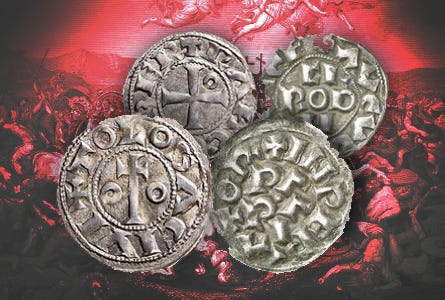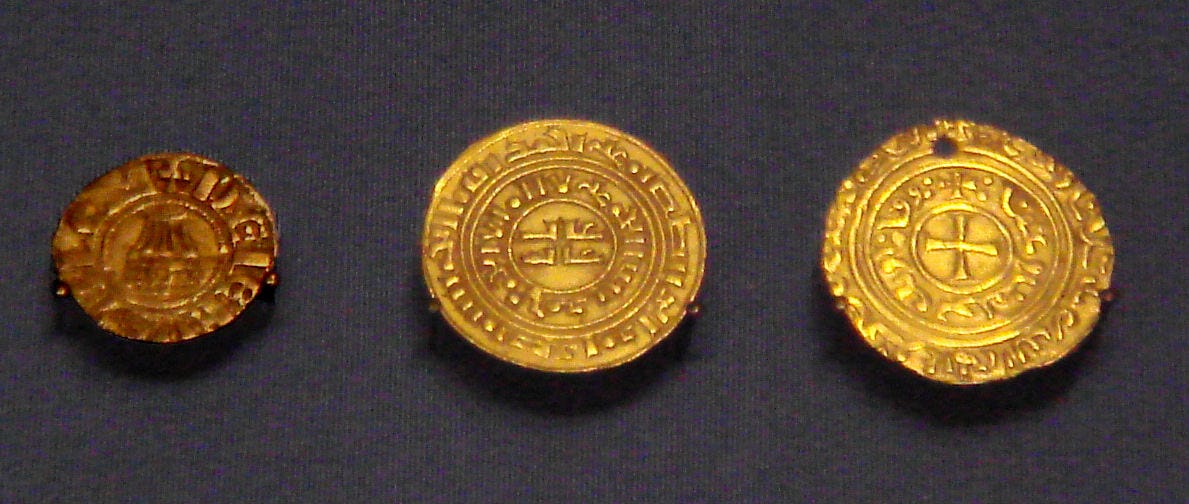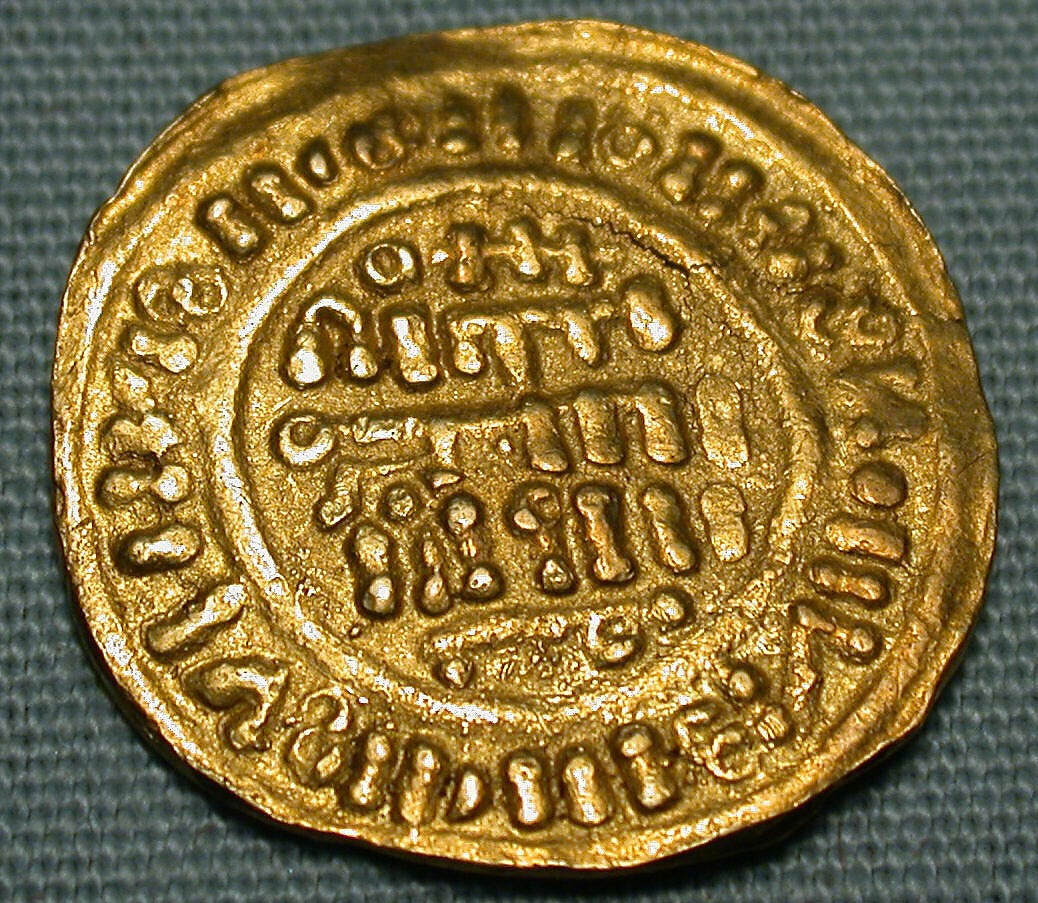Crusader money
Richard was paying a lot of money for rocks!
I know, this isn’t troubadour music, but I’ve been listening to a lot of Chris Stapleton and couldn’t resist….
Awhile back we talked about medieval time-telling, so you now know (if you did not already) what compline is. And you can decipher things like ‘on the third of the calends of April’ or ‘the ides of March’. But how much is a bezant worth? A denier? Anybody?
I’ve been researching the Siege of Acre. Richard’s siege engines had reduced part of the walls of Acre to rubble. But next to the walls was a 90’ deep ditch which the Crusaders had to attack across, and it had been more-or-less filled in. The rubble was impeding attack progress, and further, the rocks were being recovered by the Muslims and the walls rebuilt, so Richard offered 2 gold bezants (and later 3, then 4) for each rock recovered from the walls. (Note that as you tried to recover a rock, you were being fired on with arrows from the walls). You might be left wondering a) what the heck is a bezant, and b) what is it worth?
As I have researched Richard and the Third Crusade, I regularly come across episodes where specific amounts of money are mentioned, and it always feels cryptic. Richard was eventually to be held hostage and ransomed for 100,000 marks. In How to Plan a Crusade we learned Richard spent £50 for 60,000 horseshoes. Or as Richard de Templo tells us, during the worst of the siege of Acre, “A moderate measure of wheat, which a man could carry under his arm, was sold for 100 aurei, a chicken for twelve sols, and an egg for six deniers.” You expect that means a lot, but you’re not really sure how much.
Let’s decipher.
To begin with, we are dealing with people from many countries and a diverse set of measures. There’s the English currency system, the French, the Byzantine, the Arab, and so on. Most of the European systems were descended from the Roman system of libra, solidus, and denarius (plural denarii).
Solidus = 4.5 grams of gold (at today’s gold prices, about $285).
= 12 denarii
In the New Testament, a denarius is mentioned as a day’s wages for a common laborer.1
The solidus replaced the gold aureus (plural aurei), roughly equivalent in value (the aureus was 7.3g vs 4.5g for a solidus). It’s worth mentioning that currency systems and values fluctuate over time so we are dealing here in some over-simplifications when we talk about equivalences and values.
As we get to the Middle Ages we see various systems derived from the Roman system:
English2
The English system - £sd (or Lsd) for pounds, shillings and pence are derived from the Roman libra, solidus, and denarius.[13] Hence pound is a pound sterling of silver, and the (d) abbreviation for pence comes from ‘denarius’.
£1 pound = 20 shillings
= 240 pennies, or pence (£1 = 20s = 240d), as it would be written.
French3
The main unit is the livre (“French pound” consisting of a French Pound (12oz, not 16oz, of silver).
1 livre = 20 sols
= 240 deniers
Similarly, the Spanish word ‘dinero’ is descended from ‘denarius’.
Byzantine4
The Byzantine Empire was essentially the continuation of the Roman Empire, which moved to Byzantium (‘Constantinople’, ‘Istanbul’) after the collapse of Rome. The bezant5 was a gold coin and the currency of Byzantium. The term also came to be applied to gold dinars produced in Arab countries, and to gold coins produced by the Crusaders in the Kingdom of Jerusalem.
All of them were roughly equivalent to the solidus, containing 4.5 grams of gold.
Arab6
The main unit was the gold dinar, the word derived from ‘denarius’, but the value was more like the more valuable bezant/solidus. A lessor value coin was the silver dirham.7 So far as I can tell, the medieval gold dinar contained about the same amount of gold as a solidus.
German
In the medieval era in Germanic areas, the mark was a measure of weight, roughly 2/3 of a pound. The currency, a mark, was therefore worth 2/3 the value of a pound, and coins would typically be silver.
Throughout the medieval era, the value of a coin of precious metal was more directly related to its weight, than any nominal ‘currency value’. The solidus, bezant and related coins are sometimes listed as 4.4g, rather than 4.5g; we’re going to stick with 4.5 to simplify the math.

Conversion
It’s hard to find explicit mention of the conversion from gold to silver value in the medieval era. By my calculation, (very roughly) 10 bezant = £1.89
(By the way: if you are interested in the coins themselves, lots of pretty pictures and great information here: https://coinweek.com/medieval-numismatics-coins-of-the-crusaders/
Valuation
OK, now that we have our terminology set, how much were all these things worth?
One can certainly equate them by gold value (at today’s gold price, a bezant was 4.5g of gold, so about would be worth about $285). But it’s not clear that’s a good measure, given currency is ubiquitous today and many medieval people did much of their business through barter or non-currency-based transactions.
More interesting would be to compare how much people earned, or the purchasing power of the currency.
Some salaries
From various sources10111213, we might find the following “salaries”:
Laborer (1d a day, £1-2 a year)
Archer (3d a day, £4-5 a year)
Soldier’s annual salary pegged here at 12 solidi (say, 1 bezant a month)14
A knight’s (£10-20 a year)
A knight (from another source): 2sh a day, £36 a year
Purchasing power
It must be pointed out that the data points we have on purchasing power come from different times during the middle ages so all of these must be considered rough estimates for costs during Richard’s era.
The medieval cost of a vast number of goods are itemized here. Fun reading. A few examples:
A cow might be 10s, a pig 3s, 2 chickens for 1d.
We saw in How to Plan a Crusade that Richard paid £101 for 14,000 cured pigs (1£ = 138 pigs, or ~6s per pig) and £50 for 60,000 horseshoes (5d per horseshoe).
Elsewhere we find that a pack horse might cost 10s, and true warhorse an astronomical £4015, and that a glass of wine at an inn might cost you around a penny/pence16.
At a larger scale:
When Richard built his last, famous castle, Chateau Gaillard, it cost him £11,000 (or the equivalent of 10,000 man-years of laborer effort).
A full year of normal royal revenues for England might be around £25,000 pounds.
Conclusions
So, returning to Acre. When Richard offered 2 gold bezants for a rock, what was he offering?
2 bezants = roughly 2-4 month’s pay for a soldier!
When a bag of wheat cost 100 aurei, it was costing 100 bezants or literally years of labor! A chicken at 12 sols = £0.5 or 6 months salary! A egg for 6 deniers was a bargain at roughly a day’s salary!
Those were bad times, as they say, and it is easy to see why the Crusaders were so ecstatic to see Richard show up, fresh off a victory at Cyprus and with ships loaded with food.
Richard’s ransom of 100,000 marks (£66,000), equated to roughly 3x the annual revenues of the government, or 60,000 man-years of labor cost.
Hope you enjoyed the brief monetary digression. Our next episode, we’re going to talk about siege tactics!

https://en.wikipedia.org/wiki/Denarius
https://en.wikipedia.org/wiki/Pound_sterling
https://en.wikipedia.org/wiki/Livre_parisis
https://en.wikipedia.org/wiki/Byzantine_coinage
https://en.wikipedia.org/wiki/Bezant
https://en.wikipedia.org/wiki/Dinar
https://www.linkedin.com/pulse/history-money-islam-estimating-value-classical-dinar-qureshi/
https://www.worldhistory.org/Byzantine_Coinage/
Which says that 12 silver miliaresions were equal to 1 nomisma (Byzantine), which was in turn the same amount of gold as a solidus / bezant, 4.5g of gold. Miliaresions were 144 to the pound, so 12 miliaresions = 1/12pound silver = 1 bezant, so 12 bezants = 1 pound. This is my calculation, any errors mine…
Elsewhere, one reads that the value of gold was roughly 10-20x the value of silver, so 10 bezant = 45g of gold = 450-900g of silver = 1/2 - 1 of a pound. So for rough mental arithmetic say 1 bezant = 1/10 of a pound.
(UPDATE) Since writing this post, I have been looking Hosler’s book The Siege of Acre, which has the following interesting table of the exorbitant cost of food at the siege. It has the conversion rates of 70 deniers to the bezant, whereas my 10 bezants to the pound equates to more like 35 deniers to the bezant. His 60 shillings to 30 bezants is essentially the same as my 10 bezants to the pound, and his marks/bezants ratio is also about the same.
Item Acre price in bezants 1939 value 2016 value
One egg: 12 deniers 0.17 £0.51 £30.91
One gallon of milk 10 soldi 1.7 £5.10 £309.06
One chicken: 60 sous 10 £30 £1,818
Four bushels of corn 15 shillings 30 £90 £5.454
A loaf of bread 60 shillings 120 £360 £1,281
A horseload of corn 64 marks 427 £21,816 £77.628.60
https://www.amazon.com/Time-Travelers-Guide-Medieval-England-ebook/dp/B0030MQJL4/linkCode=ll1&tag=codexmap-20
https://castellogy.com/history/medieval-money
https://www.luminarium.org/medlit/medprice.htm
https://dailymedieval.blogspot.com/2013/10/the-bezant.html
https://www.nga.gov/features/byzantine/imperial-coinage.html
https://aprilmunday.wordpress.com/2020/06/14/medieval-horses-part-two/
https://www.harp-tdm.info/harp-tdm-univers/content/200-annexes-economie/30-medieval-price-list/medieval-price-list.pdf




Lots of interesting info! And lots of $$ spent ....